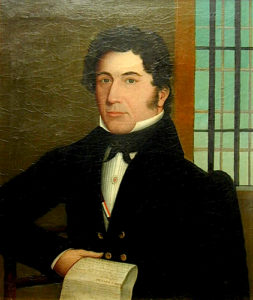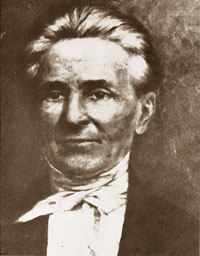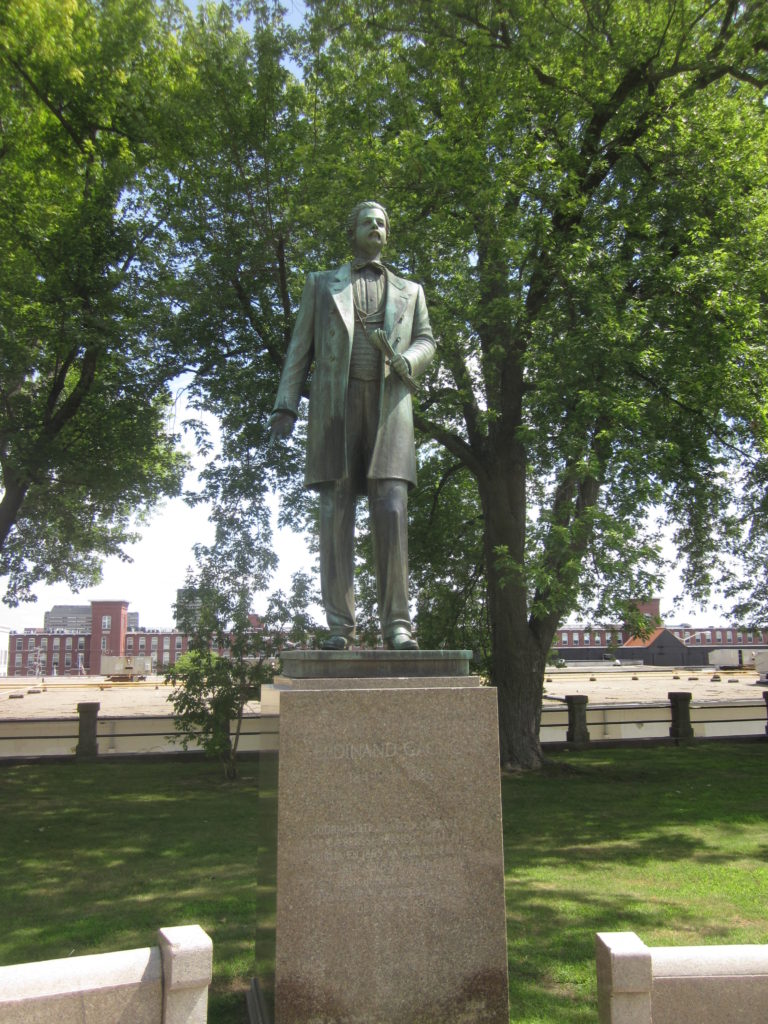This week, in connection with Quebec’s “national” holiday, la Saint-Jean-Baptiste, we see how budding Franco-American communities celebrated the day in nineteenth-century New England. Until the mass emigration of Catholics to the region, only Masonic lodges had attributed any significance to June 24. The arrival of French Canadians fashioned St. John’s Day into a semi-official holiday in most areas where they formed a substantial portion of the urban population.
Although political considerations stimulated the creation of the first société Saint-Jean-Baptiste in 1834, the celebration of June 24 in Lower Canada (later Quebec) became an increasingly religious ritual in the 1840s and 1850s. The pageant came to reflect the spirit of survivance—an unwavering desire to preserve the French language and ancestral customs, by which they would also secure the glory of the Roman Catholic faith in North America. Still, as some of the following excerpts indicate, political concerns did linger.

In New England, la Saint-Jean provided French Canadians with an opportunity to show that they could maintain their inherited cultural identity while respecting American laws and asserting their commitment to U.S. republican institutions.
The following articles are reproduced with the original spelling from the Boston Daily Globe.
Lowell, Massachusetts, June 24, 1873:
St. John’s day was celebrated here, to-day, in an enthusiastic manner by thirteen societies de la Jean Baptiste from different sections, under the auspices of the St. Jean Baptiste and St. Joseph societies of this city. Each society was accompanied by a band, and the twelve or thirteen hundred persons in the procession, with their imposing banners and regalias and rich music, presented an unusual attraction. Quite a number of stores and public buildings were decorated, and the words, “Liberte, Equalite, Fraternite,” and “Papineau, Lafayette and Washington,” were conspicuous upon American flags suspended across the street in the central portion of the city […] Mr. Gagnon spoke for nationality, Mr. Houde for naturalization, with severe criticism of England, and all strongly urged Canadian independence of the mother country, and were loudly applauded.
Lowell, June 24, 1875:
The day was very warm, but there was a good turnout. A procession was formed at 10 o’clock under direction of L. P. Lamathe as Chief Marshal, and F. Cote, J. Pouillate and F. Reignier as aids […] The procession included societies from Haverhill, Boston, Lawrence, Fall River, North Cambridge and Great Falls, N. H. There were carriages containing the clergy, speakers and invited guests. In a carriage drawn by four horses was a child representing St. John the Baptist. The procession was quite large and imposing in appearance.

Lowell, June 24, 1881:
Today the French Canadians made the most extensive and imposing display ever witnessed in this city in observance of St. John’s day. At 8 o’clock, a pontifical high mass was celebrated at St. Joseph’s Church on Lee street […] At 10 o’clock the large procession was formed in four divisions and at 10.15 o’clock moved through the principal streets to the fair grounds […] In the line appeared l’Union St. Jean Baptiste, le Cercle Canadien, l’Union St. Joseph, l’Association des Jeunes Gens and le Societe de l’Ange Gardien […] The streets were thronged with people while the procession was passing over the route, and the best order was maintained by the police.
Woonsocket, Rhode Island, June 24, 1882:
The celebration of St. John’s day here today called together one of the largest assemblages of French-Canadians ever in New England. All business was suspended here and in neighboring Rhode Island and Massachusetts towns. Incoming morning trains brought from four to five thousand visitors […] The whole is designed to illustrate the progress of the French people in the United States. There will be a picnic and athletic sports this afternoon. The observance will be closed this evening with dramatic and literary exercises.
Worcester, Massachusetts, June 25, 1883:
Yesterday being St. John’s day (June 24), the French Canadians celebrated today in a style that reflects credit upon themselves and the management of all the ceremonies […] There seemed to be but one drawback to the celebration in the morning, namely, that Governor Butler and staff, who were assigned a prominent place in the procession, could not be present. […] [T]he committee of arrangements waited upon Judge Advocate General Verry of this city, and he took one of the early trains for Boston, promising to return with the Governor in the afternoon, which he did at 3.30 o’clock. A despatch from Boston announced the time the Governor would arrive, and the societies, who had to all intents and purposes been dismissed for the day, and who were participating in the banqueting and merry-making at Bigelow’s garden, were reformed in line […] the Governor addressed a large French audience, detailing some of the services of Lafayette towards the American Republic, and congratulating his audience upon their fine and orderly celebration.
Fall River, Massachusetts, June 25, 1883:
Most of the mills shut down at noon, owing to the large number of employes away, and the streets presented a holiday appearance, many buildings displaying the French tri-color. The proceeds of the picnic at Forest Hill will be devoted to charity, one-half to the French orphan asylum recently established here and one-half to the widow of Chevalier De Lorimer, the French patriot, who was recently found living in poverty in Canada.
Pawtucket, Rhode Island, June 24, 1885:
The French Canadians of this town and vicinity celebrated St. John’s day this evening by a grand procession of organizations and military bodies and trade representatives, the line being over a mile in length. The procession marched under four large gayly decorated arches, while Harrison street and Lonsdale avenue were ablaze with illuminations, fireworks and bunting. The St. Jean Baptiste societies of Providence, Central Falls and Woonsocket were in the line, and the military portion comprised the Central Falls and Valley Falls Cadets and the Kearney Light Infantry. After the parade, vocal and musical exercises and speeches took place at Music Hall.

Haverhill, Massachusetts, June 25, 1886:
At 9 o’clock, a procession having been formed, the column moved in the following order:
- Chief Marshal, Joseph Ethier.
- Assistants, M. Mercier, Augustus Bourneuf, Charles Bourneuf, Edward Lapiere.
- Mounted platoon of police, Captain J. O. Lucy commanding.
- Drum Major George N. Millett, Lafayette band, twenty-one pieces.
- French color bearers.
- St. Jean de Baptiste Societe, Joseph Gervais commander.
- French societies – Uniformed cavalry.
- Allegorical chariot group, the child and lamb, the symbol of St. Jean de Baptiste. Motto: “Dieu et Mon Droit,” and “Par Ce Signe Vincra.”
- Allegorical chariot, motto, “Decouverte du Canada, 1534 – Jacques Cartier et le Coureur Des Bois.”
- Group, a canoe containing Jacques Cartier, the Canadian discoverer and Indian guide.
- Uniformed cavalry.
- Barouche, five generations of the Roy family – Charles, aged 105 years; J. B., aged 76; Charles, aged 47; Charles Boucher, aged 26; M. K. Boucher, aged 10 months.
- Barouche, Fathers Boucher, Pathier, M. E. Marier and President St. Jean Baptiste.
- Barouche, invited guests.
- Barouche, crowned young ladies.
- Allegorical chariot, motto, “Dominion du Canada”; group of young ladies representing Canada and her provinces.
- Allegorical chariot, motto, “Unisonnous les uns et les Autres.”
- Allegorical chariot, motto, “Nos Gloires Nationales Depuis Christophe Columbe Champlain Jusqua Papineau.”
- Trades representations in line – twenty-one different trades from brick to shoemaking.
- Group representing the manufacturers of cloth in the olden style – two old ladies with an old-fashioned spinning-wheel and another lady with loom, motto, “Souvenir de la Patrie.”
- Barges containing young ladies and boys and girls.
Nashua, New Hampshire, June 19, 1888:
The International French Canadian convention and celebration which will be held in this city from June 26 to 28 inclusive, will be the greatest French Canadian demonstration of the kind ever held in the United States […] Nearly every society named in the above list will have a band or drum corps accompanying them. Captain M. Labreche of Manchester will be chief marshal and Dr. J. Hills of Woonsocket, R. I., first assistant. It is estimated by careful count that there will be fully 9000 men in line […] The parade will take up an extended line of march and will close with a grand dress parade and review at the grounds at the harbor, which, it is claimed, is large enough to allow 100,000 people to review the ranks. Forty thousand people will be fed on the grounds at one time […] All sorts of amusements have been arranged by the committee, including a game of lacrosse between the Indian Lacrosse Club of Montreal, who are at present champions of Canada, and a strong club yet to be selected, Japanese day fireworks, a grand concert by L’Harmonie band, 55 pieces, of Montreal, the best band in the Dominion.
Manchester, New Hampshire, June 26, 1890:
Not since the dedication of the soldiers’ monument, Sept. 11, 1879, have the streets of Manchester witnessed such a parade or re-echoed to such jubilant music as has been seen and heard here today, on the occasion of the French Canadian State convention parade […] Portraits of Washington, Napoleon, Lafayette and McMahon and representations of St. John the Baptist are displayed in many of the shop windows […] On arriving at St. Augustine academy a beautiful American flag was unfurled, and as it climbed to the dizzy height of 152 feet, gracefully ascending a beautifully symmetrical staff, the vast crowd gave expression to a mighty cheer of approval, the children of the academy sang “Hail Columbia,” the band played “The Star Spangled Banner.”
Addendum (2018-06-25):
The Saint-Jean-Baptiste is still celebrated in the U.S. Northeast in 2018, in some places after a lapse of many years – Lawrence, Massachusetts, and Cohoes, New York, are perfect examples. You can learn more about recent community celebrations and the revival of historical commemoration at the History News Network.
Other chroniclers of Franco-American history have similarly shared accounts of the Saint-Jean as celebrated on U.S. soil. See especially this article on the celebration of the holiday in Minnesota in 1883, courtesy of Vicky Lapointe, and similar accounts from Maine (see here and here), carried by James Myall on his blog.
Pingback: An Introduction to French-Canadian Folklore & Franco-American Culture – Moderne Francos
Pingback: A History of Saint-Jean-Baptiste Day in the US – Moderne Francos
In the 1950’s and 60’s Manchester, NH had huge annual parades down Elm St., It was replete with floats, princesses, a queen of the parade and bands. One year WMUR-TV even broadcast it live. After the parade the floats were lined up at what was then called Athletic Field (Gill Stadium) for people to get a closer look. As a child I got to ride on the wueen’s float dressed as a page boy. Very fond memories.